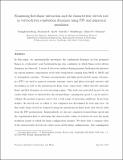Examining flow-flame interaction and the characteristic stretch rate in vortex-driven combustion dynamics using PIV and numerical simulation
Author(s)
Speth, Raymond L.; Ghoniem, Ahmed F.; Hong, Seung hyuck; Shanbhogue, Santosh
DownloadCNF2013_1_HongSpethShanbhogueGhoniem_accepted.pdf (9.442Mb)
PUBLISHER_CC
Publisher with Creative Commons License
Creative Commons Attribution
Terms of use
Metadata
Show full item recordAbstract
In this paper, we experimentally investigate the combustion dynamics in lean premixed flames in a laboratory scale backward-facing step combustor in which flame-vortex driven dynamics are observed. A series of tests was conducted using propane/hydrogen/air mixtures for various mixture compositions at the inlet temperature ranging from 300 K to 500 K and at atmospheric pressure. Pressure measurements and high speed particle image velocimetry (PIV) are used to generate pressure response curves and phase-averaged vorticity and streamlines as well as the instantaneous flame front, respectively, which describe unsteady flame and flow dynamics in each operating regime. This work was motivated in part by our earlier study where we showed that the strained flame consumption speed S[subscript c] can be used to collapse the pressure response curves over a wide range of operating conditions. In previous studies, the stretch rate at which S[subscript c] was computed was determined by trial and error. In this study, flame stretch is estimated using the instantaneous flame front and velocity field from the PIV measurement. Independently, we also use computed strained flame speed and the experimental data to determine the characteristic values of stretch rate near the mode transition points at which the flame configuration changes. We show that a common value of the characteristic stretch rate exists across all the flame configurations. The consumption speed computed at the characteristic stretch rate captures the impact of different operating parameters on the combustor dynamics. These results suggest that the unsteady interactions between the turbulent flow and the flame dynamics can be encapsulated in the characteristic stretch rate, which governs the critical flame speed at the mode transitions and thereby plays an important role in determining the stability characteristics of the combustor.
Date issued
2013-03Department
Massachusetts Institute of Technology. Department of Aeronautics and Astronautics; Massachusetts Institute of Technology. Department of Mechanical EngineeringJournal
Combustion and Flame
Publisher
Elsevier
Citation
Hong, Seunghyuck, Raymond L. Speth, Santosh J. Shanbhogue, and Ahmed F. Ghoniem. “Examining Flow-Flame Interaction and the Characteristic Stretch Rate in Vortex-Driven Combustion Dynamics Using PIV and Numerical Simulation.” Combustion and Flame 160, no. 8 (August 2013): 1381–97.
Version: Author's final manuscript
ISSN
00102180